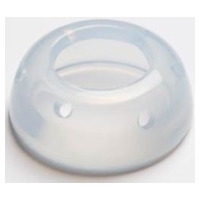The most frequent asked questions for patients
No decision about you without you!
Medical questions to discuss with your physician
How can I find a physician with experience in pessary treatment?
 Pessaries can be inserted by your physician if this is clinically indicated. For physicians unfamiliar with the Arabin pessary, instructions are provided within each package and also as a pdf-file at www.dr-arabin.de. If your physician has little experience with pessaries, you should be referred to units and obstetricians who do have such experience. Some of them are listed for different countries on our home page. There are different health care structures across the world. Some systems have specialist preterm birth prevention clinics, other systems rely on a generalist obstetrician to have a bit of knowledge of every area of pregnancy. This can lead to large variation in knowledge as it can be difficult to keep on top of all new developments in healthcare. Not every clinician will be familiar with the pessary. Therefore you should always ask for the instructions and label of the package (Figure), which indicates the size and charge number of the pessary. This can be shown to the physician in charge if you are readmitted into the hospital unexpectedly. It is important to attend hospital if you have contractions, loss of amniotic fluid, or bleeding. If you feel that your questions are not properly answered, you may write to: info@dr-arabin.de. We will try to answer within 1-2 working days. No decision about you without you!
Pessaries can be inserted by your physician if this is clinically indicated. For physicians unfamiliar with the Arabin pessary, instructions are provided within each package and also as a pdf-file at www.dr-arabin.de. If your physician has little experience with pessaries, you should be referred to units and obstetricians who do have such experience. Some of them are listed for different countries on our home page. There are different health care structures across the world. Some systems have specialist preterm birth prevention clinics, other systems rely on a generalist obstetrician to have a bit of knowledge of every area of pregnancy. This can lead to large variation in knowledge as it can be difficult to keep on top of all new developments in healthcare. Not every clinician will be familiar with the pessary. Therefore you should always ask for the instructions and label of the package (Figure), which indicates the size and charge number of the pessary. This can be shown to the physician in charge if you are readmitted into the hospital unexpectedly. It is important to attend hospital if you have contractions, loss of amniotic fluid, or bleeding. If you feel that your questions are not properly answered, you may write to: info@dr-arabin.de. We will try to answer within 1-2 working days. No decision about you without you!How can my doctor select the right size?
 Your physician should read the instructions or visit the home page where we placed an automatic calculator which needs your individual characteristics. It can be found at: https://www.dr-arabin.de. Select cerclage-pessary and size. This advice is based on our own experience and will be accurate for most women. However, this is not an absolute rule, and your physician should examine you personally to ensure you receive the best fitting pessary. You should always remember that if you feel significant discomfort or pain after pessary insertion, you should report your complaints and your physician may consider a change in size. No decision about you without you!
Your physician should read the instructions or visit the home page where we placed an automatic calculator which needs your individual characteristics. It can be found at: https://www.dr-arabin.de. Select cerclage-pessary and size. This advice is based on our own experience and will be accurate for most women. However, this is not an absolute rule, and your physician should examine you personally to ensure you receive the best fitting pessary. You should always remember that if you feel significant discomfort or pain after pessary insertion, you should report your complaints and your physician may consider a change in size. No decision about you without you!What is the difference between a cervical pessary with or without wholes?

 The shape of perforated (ASQ) and unperforated pessaries is identical. Increased vaginal discharge is the most common side effect of the pessary. We added holes to allow the discharge to drain and to reduce the surface area of the pessary. The holes do not make a difference to the therapeutic effect of the pessary. Both designs support the cervix aiming to prevent preterm birth. No decision about you without you!
The shape of perforated (ASQ) and unperforated pessaries is identical. Increased vaginal discharge is the most common side effect of the pessary. We added holes to allow the discharge to drain and to reduce the surface area of the pessary. The holes do not make a difference to the therapeutic effect of the pessary. Both designs support the cervix aiming to prevent preterm birth. No decision about you without you!What is the difference between a pessary which is dark blue or transparent?

 Up to 2014, the cerclage pessaries were manually produced and were blue in color (Figure left). We improved the design to use less colorant so that any impurity can be easily detected (Figure right). The new design was approved by the Food and Drug Administration (FDA) for research. The dark blue cerclage pessaries are either old or imitations where we cannot guaranty that the material has the same attitudes as tested for the transparent devices by extensive research in compressibility, cytotoxicity, sensitivity and biological tests. If unexperienced physicians may find that the color resembles amniotic membranes during speculum investigation, you may remind them that you carry this transparent blue pessary. Figure right: Transparent Arabin® pessary licensed by design, certified on a yearly basis after extensive mechanical, biological and clinical research. No decision about you without you!
Up to 2014, the cerclage pessaries were manually produced and were blue in color (Figure left). We improved the design to use less colorant so that any impurity can be easily detected (Figure right). The new design was approved by the Food and Drug Administration (FDA) for research. The dark blue cerclage pessaries are either old or imitations where we cannot guaranty that the material has the same attitudes as tested for the transparent devices by extensive research in compressibility, cytotoxicity, sensitivity and biological tests. If unexperienced physicians may find that the color resembles amniotic membranes during speculum investigation, you may remind them that you carry this transparent blue pessary. Figure right: Transparent Arabin® pessary licensed by design, certified on a yearly basis after extensive mechanical, biological and clinical research. No decision about you without you!When is the cervical pessary best inserted?
 The time or week of pregnancy when a pessary is best inserted depends on the following characteristics:
The time or week of pregnancy when a pessary is best inserted depends on the following characteristics:
- Your obstetric history (risk factors for preterm birth e.g. conization, previous preterm birth, twins in the present pregnancy)
- The cervical length
- A possibly rapid change in cervical length
You should be re-assured by your obstetrician that she or he will consider all these things when making the decision to offer you a pessary. When several risk factors are present, it seems better to start earlier in gestation and/or with earlier signs of threatening preterm birth. No decision about you without you!
How do I know that a cervical pessary is placed correctly?
 After insertion of a pessary you should get up and walk without feeling any discomfort. If it is painful the pessary is not inserted correctly and your treating doctor should examine you to check the position. Your gynecologist should arrange a check-up to ensure that the pessary does not move once it has been inserted. She or he should have studied and then pass you the instructions in case you see another gynecologist unexpectedly (Figure). No decision about you without you!
After insertion of a pessary you should get up and walk without feeling any discomfort. If it is painful the pessary is not inserted correctly and your treating doctor should examine you to check the position. Your gynecologist should arrange a check-up to ensure that the pessary does not move once it has been inserted. She or he should have studied and then pass you the instructions in case you see another gynecologist unexpectedly (Figure). No decision about you without you!Can a pessary be used in spite of a previous miscarriage or a termination of pregnancy?
 Having a previous miscarriage or a termination of pregnancy does not prevent you from having a pessary fitted if it is required. In case of repetitive late miscarriages pregnant women should be advised early in pregnancy by experienced specialists to discuss the best options of therapy. No decision about you without you!
Having a previous miscarriage or a termination of pregnancy does not prevent you from having a pessary fitted if it is required. In case of repetitive late miscarriages pregnant women should be advised early in pregnancy by experienced specialists to discuss the best options of therapy. No decision about you without you!Can two pessaries be used (cervical & prolapse pessary)?
 As far as we know, that has not yet been performed and we would not advise this due to the discomfort of wearing two pessaries and risk of necrosis of the cervix. In cases of severe genital prolapse without cervical shortening a club pessary (like a Gelhorn pessary, see Figure) better holds the organs and this may allow walking and relief of the symptoms. No decision about you without you!
As far as we know, that has not yet been performed and we would not advise this due to the discomfort of wearing two pessaries and risk of necrosis of the cervix. In cases of severe genital prolapse without cervical shortening a club pessary (like a Gelhorn pessary, see Figure) better holds the organs and this may allow walking and relief of the symptoms. No decision about you without you!Can a pessary be used in (twin) pregnancies after IVF?
 IVF itself is not a reason to need a pessary. However, patients after IVF treatment have an increased risk of preterm birth in singleton and twin pregnancies. Therefore cervical scans should be performed to monitor the pregnancy. A pessary can be used if a short cervix is detected. No decision about you without you!
IVF itself is not a reason to need a pessary. However, patients after IVF treatment have an increased risk of preterm birth in singleton and twin pregnancies. Therefore cervical scans should be performed to monitor the pregnancy. A pessary can be used if a short cervix is detected. No decision about you without you!When the pessary should be removed?
 The pessary should be immediately removed when you have signs of imminent delivery with painful contractions. If you are due to have caesaren section, removal must not be forgotten. If you are unsure if the healthcare team has removed your pessary, always ask. If your waters have broken your pessary should be removed as soon as possible to avoid infection. It may be kept in to allow you to transfer to another hospital if it is better for your baby to deliver in a hospital that has better facilities to look after a very small baby. Only in very exceptional circumstances should a pessary be kept in and these will be explained to you by your healthcare team. No decision about you without you!
The pessary should be immediately removed when you have signs of imminent delivery with painful contractions. If you are due to have caesaren section, removal must not be forgotten. If you are unsure if the healthcare team has removed your pessary, always ask. If your waters have broken your pessary should be removed as soon as possible to avoid infection. It may be kept in to allow you to transfer to another hospital if it is better for your baby to deliver in a hospital that has better facilities to look after a very small baby. Only in very exceptional circumstances should a pessary be kept in and these will be explained to you by your healthcare team. No decision about you without you!Lifestyle and own decision making
Can I insert or remove the pessary myself?
 NO, because Arabin pessaries for preterm birth prevention are not the same as gynaecological pessaries to treat vaginal prolapse. Gynecological pessaries are increasingly inserted and removed by patients themselves. These devices are only needed when patients are exposed to increased physical stress. In the evening, these pessaries are then removed. The cervical pessary used in pregnant patients has different goals:
NO, because Arabin pessaries for preterm birth prevention are not the same as gynaecological pessaries to treat vaginal prolapse. Gynecological pessaries are increasingly inserted and removed by patients themselves. These devices are only needed when patients are exposed to increased physical stress. In the evening, these pessaries are then removed. The cervical pessary used in pregnant patients has different goals:
- It is inserted as high as possible in the vaginal fornix, to support the cervix, therefore it does not dilate the vagina.
- It is unlikely that it will be disturbing during sexual intercourse as it is positioned high at the level of the cervix, however, it may be felt.
- The device changes the utero-cervical angle in patients with a short cervix when any manipulation and prostaglandin secretion should be avoided.
Therefore, the pessary should stay in place and only be changed if clinically indicated. Some pregnant women requiring a pessary may also have a degree of womb (uterine) prolapse. Then the pessary will sit lower and may be felt more easily on examination. This is not a cause for concern; the pessary will remain positioned around the cervix. No decision about you without you!
Can I do anything about discharge?
 You should be warned by your care provider about the possibility of increased or watery vaginal discharge. This is not a reason to remove the pessary. The discharge can pool when lying down. It may appear heavier when you stand up and is allowed to drain with gravity. Many women report that it is worst getting out of bed in the morning after the discharge has collected overnight. The discharge can be heavy and it has been mistaken for the waters breaking or a vaginal infection. If you are uncertain, you should be reviewed by your local healthcare provider. But not every woman will experience discharge. Daily hygiene should be similar as in a pregnancy without pessary. No specific soap for cleaning, underwear, or treatment with lactobacillus “good bacteria” is recommended. If you have heavy discharge, you may want to wear a sanitary towel or panty liner to keep sensitive skin dry. No decision about you without you!
You should be warned by your care provider about the possibility of increased or watery vaginal discharge. This is not a reason to remove the pessary. The discharge can pool when lying down. It may appear heavier when you stand up and is allowed to drain with gravity. Many women report that it is worst getting out of bed in the morning after the discharge has collected overnight. The discharge can be heavy and it has been mistaken for the waters breaking or a vaginal infection. If you are uncertain, you should be reviewed by your local healthcare provider. But not every woman will experience discharge. Daily hygiene should be similar as in a pregnancy without pessary. No specific soap for cleaning, underwear, or treatment with lactobacillus “good bacteria” is recommended. If you have heavy discharge, you may want to wear a sanitary towel or panty liner to keep sensitive skin dry. No decision about you without you!When can a patient with a pessary stay at home or should be hospitalized?
 Women with “only” cervical shortening, without contractions or co-morbidity are usually not hospitalized, particularly if the social conditions at home provide a supportive environment. In fact, treatment with a pessary can additionally encourage patients to stay at home instead of being hospitalized. In case of early cervical shortening or additional risk factors such as severe funneling, membrane separation, your physician should decide whether this indicates hospital admission. In patients with no inner measurable cervical length, but enough external cervical tissue to hold a pessary, indomethacin can be used for 24–48 hours before pessary insertion with a patient advised to stay in Trendelenburg position. This reduces amniotic fluid volume, alleviates pressure on the internal os and may reduce prostaglandin release before insertion of a pessary. During hospitalization, the cervical structure can be assessed. If there are no additional symptoms, the cervix remains stable and gestational age advances, the patient can later be discharged. Please attend hospital for review if you have vaginal bleeding, abnormal discharge, you think your waters may have gone, the pessary is causing you pain or you think that you may be in labour. No decision about you without you!
Women with “only” cervical shortening, without contractions or co-morbidity are usually not hospitalized, particularly if the social conditions at home provide a supportive environment. In fact, treatment with a pessary can additionally encourage patients to stay at home instead of being hospitalized. In case of early cervical shortening or additional risk factors such as severe funneling, membrane separation, your physician should decide whether this indicates hospital admission. In patients with no inner measurable cervical length, but enough external cervical tissue to hold a pessary, indomethacin can be used for 24–48 hours before pessary insertion with a patient advised to stay in Trendelenburg position. This reduces amniotic fluid volume, alleviates pressure on the internal os and may reduce prostaglandin release before insertion of a pessary. During hospitalization, the cervical structure can be assessed. If there are no additional symptoms, the cervix remains stable and gestational age advances, the patient can later be discharged. Please attend hospital for review if you have vaginal bleeding, abnormal discharge, you think your waters may have gone, the pessary is causing you pain or you think that you may be in labour. No decision about you without you!Can I move (walk) with a pessary?
 Yes, the pessary supports the cervix during physical activities. Most patients tell us that the pessary provides relief during physical strain such as walking or standing. No decision about you without you!
Yes, the pessary supports the cervix during physical activities. Most patients tell us that the pessary provides relief during physical strain such as walking or standing. No decision about you without you!Can I swim with a cervical pessary?
 Yes, providing your cervix is closed. Ask your doctor if you are allowed to swim. Exercise in pregnancy is recommended in many countries, and swimming is considered by many to be an ideal activity for pregnant women. In women where the cervix has begun to dilate, bacteria may enter the cervix and swimming is not recommended. No decision about you without you!
Yes, providing your cervix is closed. Ask your doctor if you are allowed to swim. Exercise in pregnancy is recommended in many countries, and swimming is considered by many to be an ideal activity for pregnant women. In women where the cervix has begun to dilate, bacteria may enter the cervix and swimming is not recommended. No decision about you without you!Can I have intercourse with a cervical pessary?
 Sexuality is an important part of health and well-being. There is no evidence that intercourse can induce preterm birth, but there are concerns that if the cervix is stimulated it may release prostaglandins triggering labour. Depending on your individual circumstances, your doctor may advise you to avoid having sexual intercourse in pregnancy if your risk of preterm labour is very high. When a pessary is inserted around the cervix this should not affect satisfaction during intercourse. In patients with genital prolapse, the cervix will be lower and the pessary might be felt during intercourse. No decision about you without you!
Sexuality is an important part of health and well-being. There is no evidence that intercourse can induce preterm birth, but there are concerns that if the cervix is stimulated it may release prostaglandins triggering labour. Depending on your individual circumstances, your doctor may advise you to avoid having sexual intercourse in pregnancy if your risk of preterm labour is very high. When a pessary is inserted around the cervix this should not affect satisfaction during intercourse. In patients with genital prolapse, the cervix will be lower and the pessary might be felt during intercourse. No decision about you without you!The pessary looks big. Is it painful to insert a pessary?
 Vaginal health is a sensitive topic, several things can cause disruption of the balance in the vaginal flora. Women who use gynecological pessaries later in life are advised to use different cremes. But during pregnancy, when the vaginal mucosa is additionally supported by the high concentrations of estrogens, this is rarely indicated, but not contraindicated to use in case of vulvar or vaginal irritation. The physician may use lubricant to make insertion easier. Most women do not require any pain relief. However, if you find insertion very uncomfortable the physician may wish to examine you first to check for causes of discomfort (e.g. thrush) and discuss with you pain relief options that are available. No decision about you without you!
Vaginal health is a sensitive topic, several things can cause disruption of the balance in the vaginal flora. Women who use gynecological pessaries later in life are advised to use different cremes. But during pregnancy, when the vaginal mucosa is additionally supported by the high concentrations of estrogens, this is rarely indicated, but not contraindicated to use in case of vulvar or vaginal irritation. The physician may use lubricant to make insertion easier. Most women do not require any pain relief. However, if you find insertion very uncomfortable the physician may wish to examine you first to check for causes of discomfort (e.g. thrush) and discuss with you pain relief options that are available. No decision about you without you!When to ask for an extra control during treatment?
 If you experience increasing discomfort, bleeding, abnormal discharge or you think your waters may have broken you should be seen by a doctor. If there are no suspicious findings, you can be re-assured, otherwise there might be an indication to reposition, to remove or change the size of the pessary. Your doctor will arrange any further routine follow up and arrange the pessary to be taken out at an appropriate time. No decision about you without you!
If you experience increasing discomfort, bleeding, abnormal discharge or you think your waters may have broken you should be seen by a doctor. If there are no suspicious findings, you can be re-assured, otherwise there might be an indication to reposition, to remove or change the size of the pessary. Your doctor will arrange any further routine follow up and arrange the pessary to be taken out at an appropriate time. No decision about you without you!Does the pessary lose its function over time?
 The strength and compressibility of the silicone does not change during pessary treatment in pregnancy. The shelf life of the devices if stored under normal conditions (temperatures between zero and 40° C, without exposure to radiation) is approved to be used for a maximum of 10 years. No decision about you without you!
The strength and compressibility of the silicone does not change during pessary treatment in pregnancy. The shelf life of the devices if stored under normal conditions (temperatures between zero and 40° C, without exposure to radiation) is approved to be used for a maximum of 10 years. No decision about you without you!In which countries is the cervical pessary available?
 In Europe, the Arabin cervical pessary® is licensed by MedCert for the indication to prevent preterm birth (Identification number: MED/CERT0482 EN ISO13485 Council directive 93/42/EEC concerning medical devices). In many countries, it can be ordered by pharmacies or main distributors which are listed on the web site www.dr-arabin.de. Other requests can be made to info@dr-arabin.de. On the web site we list countries where the pessary is already registered by the national medical device institution. Registration is completed for:
In Europe, the Arabin cervical pessary® is licensed by MedCert for the indication to prevent preterm birth (Identification number: MED/CERT0482 EN ISO13485 Council directive 93/42/EEC concerning medical devices). In many countries, it can be ordered by pharmacies or main distributors which are listed on the web site www.dr-arabin.de. Other requests can be made to info@dr-arabin.de. On the web site we list countries where the pessary is already registered by the national medical device institution. Registration is completed for:
- All EU countries (including GB and Israel)
- Russia
- South America (e.g. Brazil, Chile, etc.)
- Australia
- Asia (e.g. Malaysia, Thailand, Vietnam, Iran, Arabian Emirates, Dubai, etc)
- In the US and Canada, the Arabin pessary is now under investigation and it can be used within prospective studies by an FDA exemption.
- For Africa and India, we have withheld the delivery of pessaries up to now because there should be a basic health control of pregnant women to guaranty proper indication, insertion and removal.
No decision about you without you!
